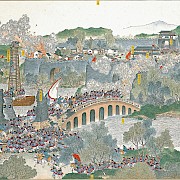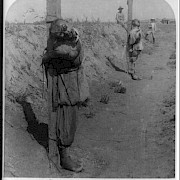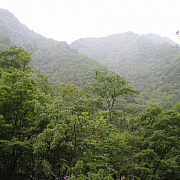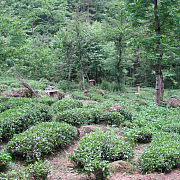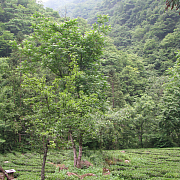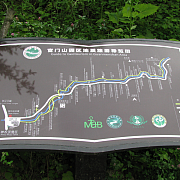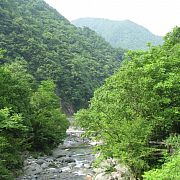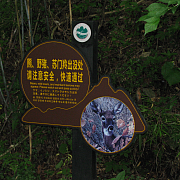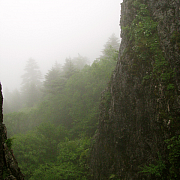First Previous Next Last
In the Eyes of the Beholder:
Rebellion as Visual Experience
Cecily McCaffrey
Images
Figure 3.1
The Qing court commissioned several paintings to celebrate their victory after the Taiping Rebellion (1850-1864), including a series of ten paintings narrating the Taiping army’s defeat, of which this image is one. Even though Taiping forces controlled key regions in central China and amassed vast armies at the height of their movement, in these paintings they are almost without exception only pictured in chaotic retreat. Accordingly, it is difficult to learn anything about the Taiping forces aside from their association with disorder and violence.Source: Wikicommons
Figure 3.1b
This image of Qing armies overcoming the Taiping troops at the provincial capital of Ruizhou is also from the court commissioned series of paintings commemorating the Taiping defeat. The well-organized blue-clad troops represent the victorious Qing armies; the clearest image of the Taiping consists of a chaotic heap of bodies in an array of various colored uniforms on the far right at the base of the city wall. A dozen more images of the Taiping defeat and scores of other paintings illustrating Qing military campaigns can be found at http://www.battle-of-qurman.com.cn/e/hist.htmFigure 3.2
A company of “Boxers” in the streets of Tianjin. While contemporary observers may not have recognized the order in the rebel ranks, the use of simple accoutrements such as armbands and colored sashes were an important means of distinguishing the rebel actors from the civilian populace, as well as a clear indicator of an individual’s commitment to the rebel cause. Flags such as the one carried by the figure in the foreground of the photo were used to organize the rebels into military formations.Source: Whiting View Company, c1901. Library of Congress Prints and Photographs, Boxer Rebellion, 1900. http://hdl.loc.gov/loc.pnp/cph.3g03917
Figure 3.3
The caption that originally accompanied this photograph from the Boxer uprising read, “After the City’s Capture – burning bodies of Chinese outside the Wall at South Gate, Tientsin, China.” Elite observers of popular rebellion provided vivid descriptions of the death and destruction that accompanied revolt and its suppression. Far removed from the conflict, it is difficult for us to imagine the emotional toll of the carnage. This photo taken in the aftermath of the Boxer uprising shows a makeshift funeral pyre set against a backdrop of damaged homes.Source: Underwood and Underwood, c1901. Library of Congress Prints and Photographs, Boxer Rebellion, 1900. http://hdl.loc.gov/loc.pnp/cph.3c12325
Figure 3.3b
The Boxer Uprising of 1900-1901 and its suppression by the Eight Allied Armies attracted significant international media attention, as manifested through photographs and illustrations featured in news journals, popular postcards, and even through new media forms such as the “stereograph.” The photographs of the so-called Boxers often documented their executions. Although these images are best understood in the context of the Boxer Uprising itself, they can function as a visual correlate to the elite descriptions of death and destruction in eighteenth and nineteenth century revolts.Source: Underwood and Underwood, c1901. Library of Congress Prints and Photographs, Boxer Rebellion, 1900. www.loc.gov/pictures/resource/cph.3b47834/.
Figure 3.4
Crab formation and “modified” crab formation. Although many elite observers of rebellion emphasized the strange ways of the rebels, Zhang Dejian sought to convince his audience that the rebels were an effective fighting force. He provided detailed accounts of rebel tactics, highlighting the rational and strategic elements of rebel battle plans. He included illustrations of rebel battle formations in his account of the Taiping rebels; the crab formation presented here could be deployed in diverse ways depending on the conditions of battle.Source: Zhang Dejian “Zeiqing huizuan” [Accounts of the (Taiping) rebels] in Zhongguo shixuehui eds., Zhongguo jindaishi ziliao congkan, II: Taiping Tianguo [Collection of Historical Materials of Modern China, II: The Taiping Heavenly Kingdom] vol. III (Shanghai: Shenzhou guoguang chubanshe, 1952), 128-129.
Figure 3.5
The hill country of central China: battleground of the White Lotus uprising. This photograph taken in 2002 of the mountainous terrain of Shennongjia in western Hubei, P.R.C., visually depicts the conditions described by officials in their reports narrating their pursuit of “White Lotus” rebels in the countryside. Officials emphasized the difficulties of negotiating narrow mountain paths and the ever-present dangers of rebel ambush.Source: Personal collection, Sigrid Schmalzer.
Chapter Sample
What does rebellion look like? The chaos and violence of popular uprisings are often presumed rather than articulated in scholarship on Chinese rebellions; yet it is obvious that the visual impact of rebellion, as well as contemporary experience of it, directly contributed to the influence of popular movements on Chinese history. Rebellion appeared differently to select groups of historical actors: a posse of rebels might signify mob rule and chaos to an elite observer but simultaneously look like a band of brothers to an active member. This chapter will explore the different descriptions of rebels and rebellions in official documents, elite accounts, and rebel depositions. These alternative visions of rebellion overlapped and coincided in ways that highlight the relationship between the state and the people and demonstrate the impact of popular uprisings on the public order.
Visual sources relating to peasant rebellion in China in the eighteenth and nineteenth centuries are extremely limited. At best, scholars can look to a series of battle paintings commissioned by the Qing court in the late-nineteenth century or to sketched representations of rebellion that were published in the foreign press (Figure 3.1, see website). However, these visual sources have limited utility if we are to address the question posed above in holistic terms. Court battle paintings celebrate the victory of Qing forces alone; foreign representations focus more or less exclusively on foreign concerns. In order to achieve a balanced accounting of rebellion, it is necessary to turn to the written record. In an era prior to the development of visual technology such as the camera, writers created pictures with their prose; these descriptions fuel the analysis in this chapter. Accordingly, the visual images presented in this chapter can only suggest what the events and phenomena described may have looked like: readers will have to employ their imaginative faculties in order to fully appreciate rebellion in visual terms.
Even when relying on the written record, it is difficult to describe peasant rebellion in abstract terms; all that can be gleaned from the sources are hints or clues for the historian to follow. Those caught in the fray of battle routinely describe groups of rebels hundreds or thousands of people strong. One presumes hyperbole in such accounts, but the overwhelming impression is of a mass of people, usually outsiders, descending on a village or a city. Descriptions of areas prior to rebel attack usually indicate an opposite phenomenon: streets are eerily empty as denizens abandon their daily routines for flight. In mountainous regions, military officials write of unfamiliar trails forking in unknown directions, their progress obscured by mist, the area seemingly devoid of human habitation until the next rebel ambush. Fire and smoke predominate in accounts of occupied cities under siege. Burnt buildings and looted storefronts signal rebel progress through an area; yet when the soldiers arrive, the consequences are not much different. Flaming projectiles are thrown over walls, and rebel “lairs” are routinely put to the torch. Finally, there is death and destruction. Layman observers are quite vivid in their descriptions of corpses piled in the streets and the stench of rot in the air. Even battle-weary veterans comment on the extent of the carnage at the end of a siege or on the brutal consequences of mountain warfare, where a missed step is a deadly plunge into a ravine far below.
Further Reading
Cohen, Paul A. History in three keys: the Boxers as event, experience, and myth. New York: Columbia University Press, 1997.
Liu, Kwang-Ching, and Richard Hon-Chun Shek. Heterodoxy in Late Imperial China. Honolulu: University of Hawai'i Press, 2004.
Naquin, Susan. Millenarian rebellion in China: the Eight Trigrams uprising of 1813. New Haven: Yale University Press, 1976.
Spence, Jonathan D. God's Chinese son: the Taiping Heavenly Kingdom of Hong Xiuquan. New York: W.W. Norton, 1996.
Zhang, Hongxing. “Studies in Late Qing Dynasty Battle Paintings.” Artibus Asiae 60.2 (2000): 265-296.
Study Questions
1. As discussed in this chapter, if we are to understand the visual impact of popular rebellion in late imperial China, it is necessary to reimagine or even re-vision the ways in which rebellion might have appeared to different participants. Re-read the quoted section on page 51, describing the rebel in white leading two thousand followers, and imagine how this scene might have presented itself to those involved in the battle itself. How does the image presented to you in the text contrast with the photograph in Figure 3.2, taken from an event more than one hundred years later? Compare and contrast the value of textual excerpts and photographic evidence as sources for understanding the history of popular revolts – what are the unique attributes of each?
2. Military encounters between the Taiping forces and the Qing armies were often well-orchestrated events. While the paintings commissioned by the Qing court (Figure 3.1) invariably featured the Qing troops in well-ordered ranks, contemporary observers described a different scenario wherein Taiping armies utilized military organization and strategies to their own benefit. Review the discussion of Taiping military strategy on pp. 57-60. In what ways might we describe these tactics as “visual?” How do visual elements contribute to military tactics more generally?
3. Ways of seeing are invariably influenced by cultural perspectives. As narrated in the last section of this chapter, Qing officials described the areas under rebel control as wild, untamed regions. Examine Figure 3.5. What values do you associate with wilderness areas such as the one represented here? How do those values influence your historical understanding? Can you think of other historical or contemporary examples where rebellion or resistance have been associated with wilderness? Finally, can you draw parallels between the cultural associations relating to wilderness in eighteenth century China, referenced briefly in this chapter, to the cultural associations relating to wilderness in late twentieth century China, referenced in Chapter 14?
Essay
As noted in Chapter three, when reconstructing pre-modern histories, visual sources are not always available for our use. Yet there is nothing to prevent us from bringing a historical perspective to contemporary images and visual experiences. Places can “come alive” for us in a variety of ways -- here we consider how snapshots can contain a multitude of meanings, both historical and contemporary.
The photograph above presents a unique vision to each viewer. Some might see lush greenery and think of hikes and camping trips -- in other words, seeing the potential for exploration and discovery. Others might note the complete absence of human activity in the shot -- in other words, seeing the potential for preservation and/or conservation. [Those who carefully read Chapter three might imagine how this vista would have presented itself to White Lotus rebels, for whom these mountains were a haven, and to Qing imperial soldiers, who depicted these mountains as obstacles to their progress.]
Our contemporary visions of forest preserves like Shennongjia in western Hubei tend to be shaped by our views of nature as a font of resources -- while this perspective is not historically unique, it certainly bears the hallmarks of the modern era. At the beginning of the 20th century, the botanist Ernest Henry Wilson traveled to this region of western China, collecting samples and taking photographs. In his book, A Naturalist in Western China, Wilson described the area of Shennongjia as follows:
Too wild and savage for extensive agricultural development, and with a marked absence of useful mineral deposits, western [Hubei] is one of the poorest, most sparsely populated, and least known parts of China. For these same reasons it is of particular interest to the botanist, since the vegetation there has been less molested than is usually found to be the case in China generally.1
Wilson documented western China with the eyes of a scientist: portraits of trees and plants predominate in the collection preserved at the Arnold Arboretum in Boston, which may be accessed here. Wilson’s photography not only assisted in the development of the field of botany but has also been used since to document long term changes in the landscape (See the article by Chen, et. al., Detecting One-Hundred-Year Environmental Changes in Western China Using Seven-Year Repeat Photography).
Although the Shennongjia region has long been known as a primeval forest area (老林 laolin, or “old forest” in 18th century records), it was extensively logged in the 1960s and 1970s; the reserve was established in the early 1980s. Today the People’s Republic of China proudly catalogues the diversity of native plant and animal species resident in Shennongjia (See the application for UNESCO World Heritage status for Shennongjia here).
Modern views of Shennongjia that emphasize the importance of the region as a repository of unique species and resources shape the visual experiences of contemporary visitors in the areas developed for tourism. The sign that greets visitors at the gateway of Guanmenshan park in Shennongjia names the prominent geological formations on display; not only may visitors examine these sites, but they may also visit a natural museum, a nursery for rare plants, and a biological laboratory, as well as a medicinal herb garden and the tea garden pictured above. The sign identifying the tea garden highlights the ancient and modern attributes of the park in noting both that Shennong, the legendary “Divine farmer,” drank tea to mitigate the toxic effects of certain medicinal herbs and that the tea in this garden is grown organically, irrigated by mountain spring water (note as well the boxy beehives in the photos above).
Today’s Shennongjia is designed to be seen and experienced by tourists, who may make their way through the park areas via eco-friendly buses or by foot. Both pedestrian and passenger can explore the park, but both are also carefully guided towards “scenic” spots, whether by tour bus or walkway. The visitor sees and experiences natural beauty while learning about the cultural and ecological heritage of the site.
The management practices employed in the reserve areas emphasize the protection of natural species and the propagation of native plants while they delimit tourist traffic to designated pathways. Accordingly, park officials are able to exercise a protective function, in restricting human activity to certain spaces; and a conservation function, in promoting the development of native species. These functions take on a slightly different valence, however, when it comes to the “wild” nature of the space.
In the managed space of the park, nature manifests as bucolic and pastoral. However, several signs in the pedestrian areas of the park remind the visitor that this is a wilderness area. Warnings about bears, wild boars, and poisonous snakes are prominently placed along the main trail. Even if none of these creatures cross one’s path, the signs serve as an iconic reminder of the dangers of the wild.
Knowledgeable visitors to Shennongjia will know of another wild creature said to inhabit the forests of western Hubei: the “wild man” of China. Descriptions of the “wild man” are quite similar to those of Bigfoot/Sasquatch or Yeti. The evidence for the creature’s existence relies primarily on isolated sightings, often difficult to verify. (See a discussion here.) Perhaps the most descriptive characteristic of the “wild man” is that it is never seen. Nevertheless, it has proved a powerful symbol of primeval nature, perhaps most famously utilized for the purposes of cultural critique in the work of Nobel Laureate Gao Xingjian.2
The potential for strange and dangerous encounters with the wild is not limited to wildlife. The mountain mists of Shennongjia are associated with瘴气zhangqi, or miasmas. In the Chinese medical tradition, these miasmas are characteristic of hot and humid southern regions and are seen as being the cause of diseases such as malaria. Additionally, miasmas bear with them an air of the exotic, in that, during the imperial period, the regions where these so-called poisonous vapors were present were also places where indigenous peoples lived. Thus, as scholar Marta Hanson elaborates, the idea of miasmas overlapped with ideas of boundaries -- travel into strange places could be hazardous to your health!
The old English term “malaria” has to do the the perceived cause, mal aria or bad air, and refers to the results of defilement from miasmas... Zhang, on the other hand, brought together the idea of barriers -- spatial frontiers, non-agrarian mountainous spaces, and spatio-temporal regimes of climatic extremes -- with that of miasmatic poisons that are part of the environment.3
Ideas of miasmas are highly evocative; in the mountainous areas of Shennongjia, where the fog descends and the mists rise, one can only wonder what is hidden behind (or within) the clouds.
As detailed in Chapter three, what is “seen” in a particular image depends largely on the viewpoint of the observer. For an 18th century rebel, the mists of Shennongjia may have provided welcome cover; for the military official, the mists were foreboding -- signifying not only a strategic disadvantage but also rendering a strange landscape even more alien and menacing.
1Ernest Henry Wilson.A naturalist in western China, with vasculum, camera, and gun being some account of eleven years' travel, exploration, and observation in the more remote parts of the flowery kingdom. (London: Methuen, 1913), 15.
2 SeeGao Xingjian and Bruno Roubicek (trans.), "Wild man: a contemporary Chinese spoken drama"Asian Theatre Journal 7 (1990): 184-249; Gao Xingjian and Mabel Lee (trans.),Soul Mountain (New York: Harper Collins, 2000). An interesting discussion of the scientific inquiry into the “wild man” may be found in Sigrid Schmalzer,The People’s Peking Man: Popular Science and Human Identity in Twentieth-century China (Chicago: University of Chicago Press, 2008).
3 Marta Hanson,Speaking of Epidemics in Chinese Medicine: Disease and the Geographic Imagination in Late Imperial China (Hoboken: Taylor and Francis, 2011), 79.


